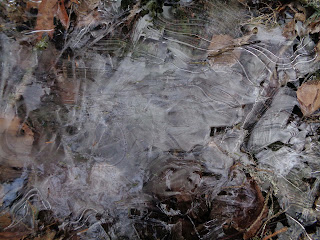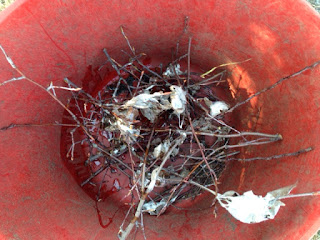Welcome to the Vinalhaven sightings Report –
March 20, 2017
Brought to you by the shared efforts of MCHT and VLT
Highlights – Great Horned Owl, Woodcock,
White-winged Crossbills, purple sandpipers, razorbill, great cormorant
 Business: contact us –vinalhavensightings@gmail.com
Business: contact us –vinalhavensightings@gmail.com
Tiit trick – click on photos to enlarge.
Upcoming things – nature wise – some woodcocks are
back, more to come, get out crepuscular and look/listen for them…..in theory,
the snow will disappear, and in theory we will get some rain when the
temperature is over 40 degrees. Drive around that evening – Spotted Salamanders will be making
their way to a Vernal Pool near you!
 |
| 31 Reach Road, March 10th |
Sightings – American Woodcock – They’re
Back!!!! (3/10)
right next to the old compost bin at 31
Reach Road, this little nugget of a tasty woodland shorebird was looking
for worms – and I hope he got enough of them! Right before the storm.
 |
| woodcock, hunkered down photo by Jim Conlan |
(3/11) Jim Conlan sent in this photo of a
local woodcock from his yard. Thanks for sharing Jim – you the man.
Great Horned Owls – are being heard around island! (3/10)
Huber Preserve – during the bonfire we heard a distant Great Horned towards the end of dusk….Jamus Drury heard one in the
early hours (3/17) “Across the pond” with the pond being
Carver’s Pond. Great Horned Owls have
been sitting on eggs for the last month or so, and young are ready to hatch! The
adults will take turns on the nest, and will call back and forth several times
before switching spots/responsibilities. The “switchings” often take place at
dusk or dawn, but can be heard just about any time after mid-afternoon.
(3/11) – Huber preserve – bunch of white-winged crossbills flew over me in
the early hours when I headed back out to check on the fire from the night
before.
 |
| yes, there is a purple sandpiper in this photo |
Ferry Ride – (3/10) – 10:30 to Vinalhaven – 28 Common Loon, 95 Common
Eider, 16 Surf Scoter, 61 Oldtailed Ducks, 5 Red-breasted Merganser, 3
Red-necked Grebe, 23 Black Guillemot, 1 Purple Sandpiper, 1 Great Cormorant, 2
Black Duck, 3 Bufflehead, 1 Common Goldeneye.
 |
| yes, there is a great cormorant in the this photo |
This was a cool ride … 95 eiders felt like a lot,
probably the most I have seen in years from the ferry. Plus the token single Purple Sandpiper and Great Cormorant were fun. But the real
story here was the molting of Black
Guillemots and Common Loons….(look below)
 |
| yes, there are seals in this photo |
(3/17) 7am to Vinalhaven…- 68 Common Eider, 23 Surf Scoter, 16 Common
Loon, 46 Oldtailed Ducks, 29 Black Guillemot, 2 Red necked Grebe, 3 Razorbill,
2 Red-breasted Merganser, 1 Bufflehead….4:30 to Rockland – Bald Eagle.
…lots of people think of the spring
migration of songbirds in May as a sign that “love is in the air” (anthropomorphism). And while “love” (the royal “love”) certainly
permeates the atmosphere in spring, those looking can see that “love process” (anthropomorphism)
starting way before May. For our intents and purposes we will define “the love process” (anthropomorphism) as
when hormones inspire plumage change or behavior changes that are “connected”
with reproduction! Yippee!
 |
| yes, this loon is going through a molt back feathers and face showing signs |
What is inspiring this conversation
here? The obvious signs of “molt” that
can be observed from the ferry. Here’s what Steve N.G. Howell (the third?) has to say about the molt process in
his hit book – “Molt in North American
Birds”
“Although
molt (or molting) is often thought of as feather replacement, it is really the
systematic process of feather growth….The loss of feathers in later molts is
usually a passive by product of new feathers growing in and pushing out the old
ones”
I think you get the picture…Steve
seems to be a bit picky about terminology – it’s not replacement, rather it is
pushing out the old feathers by new ones.
 |
| yes, this loon is a little further along than the other |
The bottom line here is that what I
went through in my early twenties, which is often refer to “my molt” isn’t molt
at all. First off I have no feathers, but also when my hair fell out it wasn’t
because new hair was pushing their way out. Nope, it was either my high levels
of testosterone (stud levels) or something about my mom’s dad (my grandpa) being
bald or whatever. I’m going with the testosterone thing.
Here’s more from Steve…..
 |
| yes, this guillemot has not really started molting yet |
“Molt
is also a dynamic evolutionary process and what we see today reflects millions
of years of ongoing fine-tuning. In some cases, a bird’s molt strategy may not
make sense to us, but this may be because there has not been enough pressure to
change a strategy that worked well thousands of years ago”
We can use Common Loons as an example
of what Howell talks about with “strategies making sense to us or not”. Common
Loons are going through the molt process right now as I type or when you read! For
me and lots of others, this is a good time to have a beard, not to molt. Anyway,
here’s some more about Loons
“There
are only a few times in their annual cycle when loons can molt their wings, and
these time constraints are overcome by having a synchronous wing molt. By
shedding their primaries and secondaries at the same time, birds become flightless for a few weeks while new wing
feathers grow. Another advantage of this strategy for heavy-bodied birds with
small wings is that a short period of no flight may be better than a prolonged
period of labored flight”
Ever watch a loon fly? Can look
somewhat like a struggle or hassle. Imagine them trying to fly with some of
their flight feathers gone. Not pretty. Better to ditch them (flight feathers)
all at the same time, that’s what evolution has done with them. Here’s more on
this..
“unlike
geese and swans, which undergo synchronous wing molt while tending young, both
members of a breeding pair of loons need
to remain fully winged for territory and brood defense, as well as commuting to
feeding areas. The traditional view has been that larger loons don’t have the
time for wing molt before northern waters freeze up, so they postpone it over
the winter until favorable conditions return in early spring.”
 |
| yes, this guillemot is almost there, little white on the face |
Many factors –
length and intensity of daylight, age, and hormones (of course) to name a few –
play a role in triggering molt. Black
Guillemot molt seems to be closely connected to daylight length as molt can
be observed in individuals as early as the first week of January – with daylight
length starting to increase December 21st (obviously). Here are a
few shots from the ferry of Black Guillemots in different molt states.
(Sea) Ducks - here’s a different strategy, timing wise…. Common
Eiders are the only sea duck that regularly breeds locally and are a good
example of duck timing.
 |
| yes, this surf scoter is molting out of its juvenile plumage |
Ducks breed in the spring, after
which the males molt into eclipse plumage (when they appear like
females/juveniles) for the summer. Many male Eiders go offshore or to staging
areas at this time and molt their flight feather all at once, and are flightless
for a few weeks. Starting in early fall the males molt back into their classic
white on top/black on the bottom and the females stay with their classy “brown”
look. And that is when courtship starts up.
 |
| yes, this eider has been looking sharp since round November |
Most sea ducks that visit Vinalhaven
waters for the winter (“from away” ducks) show up in mid-late November and have
already molted into breeding plumage and are ready to court. Red-breasted
Mergansers show up a little earlier and when they do they all look the same.
They molt in our waters!
So Eider males look sharp these days
and have since Novemberish. Nothing to do with daylight getting longer, because
they actually molt as the days are getting shorter.
 |
| apparently these dudes (oldtails) are hot enough to attract some mates without molting |
The exception here is Old tail ducks,
formerly known as Oldsquaws, and in books mislabeled as the insulting Long-tailed
Ducks. Apparently their non-breeding plumage is “hot enough” to attract a mate,
and they don’t really start molting into their “breeding plumage” until they
get ready to head out – in April and May and thus the timing of their outwardly
appearance changes is a little different than the others. Go old tails! Be your
own species!
 |
| look closely, there is an otter trail captured in slush a little to the right of center heading across Old Harbor Pond |
Otter stuff –
(3/17) Old Harbor Pond - had some time
and saw some trails from the road (I love spotting otter trails from the car,
makes me feel like a millennial or an American or just me!) so Jamus and I strolled
around and followed trails from a pair of otters that went from OHP to sands
cove. It was so cool.
The historic den is still in use (no
surprise) and tracks in the latest snow where fun to follow. That last snow was
famous (in some minds) for having a nice layer of ice on top of the several inches
of snow and the otter trails showed how the otters dealt with is.
 |
| trails and tracks showed a lot of activity at otter den |
 |
| the ice on the snow made for some interesting
tracks and trails
|
 |
| view from the latrine. there are two trails in the middle of the sun glare coming from the rocks across the pond. pretty cool. |
On the pond ice, where the snow was
wind blown and the ice was slushy and the trails from the den to the latrine
were captured in slush. These were the trails I spotted from the road. Too easy!
 |
| alternative entrance to otter den |
 |
| snow fleas. of course |
Once the otters pooped their hearts
out (loose interpretation) at the latrine they headed to the sand cove and the
ice covered snow made for a trail of bounds that break the ice, rather than
belly slides that would be productive in soft snow.
Cool to see a pair of trails, cool to
see that the den is still active, but coolest to get out on Old Harbor Pond! My
favorite ice place in Maine by far.
 |
| inside washing Nanni's car |
the sickness is starting to finally release my family from its grips. coughs lasted three weeks or more, but we are getting better, thank you for the kind thoughts I have received since the last VSR.
 |
| he was not going to try and catch the GBH with the net. I swear. |
so little exploration with the boy has taken place recently as we have been healing.
here's a couple of classics from Christmas in South Carolina.
see you out there!






















